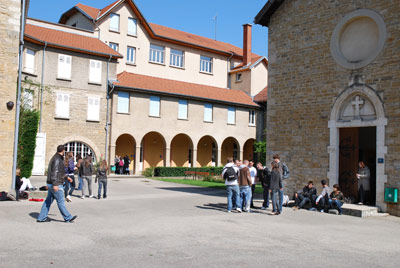Weekly Exchange: French vs. American schools
In the latest installment of Weekly Exchange, WSPN’s Emma Nallet discusses the European refugee crisis from a new perspective after she gained a different insight during her experience in the US.
Whether it is in France or the United States, school has been an essential place in students’ lives. In both countries, students spend about 13 years of their existence at school if they start in kindergarten and graduate at 18. Even though we have this common likeness, numerous differences separate the French and the American academic systems. These dissimilarities stand out particularly in high school, which French students begin in the 10th-grade.
Schedule
It is obvious that French and American schools differ from each other in many ways, and time management is one of them. French school days are usually much longer, beginning at 8 a.m. and ending at 5 or 6 p.m. — except on Wednesdays, which end at noon. Just like the American system, school is closed on the weekends. Although French school days are longer and the amount of homework is generally greater, the students also enjoy longer vacations. In fact, we have two weeks off in the fall, winter, April and for Christmas, along with two months over the summer. However, the holidays are, at the same time, an occasion for teachers to give us more considerable homework assignments. In France, lunch also holds a prominent place in student’s schedule. The midday meal, which lasts about one hour, occurs in the school restaurant, where we eat a full, hot meal. Students are usually not allowed to bring their own lunch and have to choose from the school menu, which changes every day. Students in high school also have the choice to have lunch outside of school, but the majority eat from the school menu.
Sports & After-School Activities
It is impossible to talk about American high school without taking into consideration after-school sports and their predominant position. Since I arrived in the U.S., I have been continually amazed by the importance of sports in American students’ lives. Here, sports can play a crucial role in admission to college, and many students make it their utmost goal to be a part of the varsity team. In France, we have only two mandatory hours of “physical education” per week. The sports teacher (because coaches do not exist in France) chooses a new sport every trimester that involves several criteria, such as team spirit or creativity. Unlike in the U.S., sports usually don’t have a dominant place in students’ lives. On Wednesdays after 12 p.m., we also have the opportunity to be a part of an “Association Sportive,” which is more similar to after-school sports in the U.S. Students can choose between several sports such as volleyball, badminton or running, and they practice for two hours after school each Wednesday. In France, the concept of clubs is also very limited — they’re almost nonexistent. We do have a couple of clubs including journalism, chess, culture and science clubs, but no outstanding or original ones that you can find in the U.S. Likewise, if we do have clubs, they do not meet after school, but rather during lunch break. The length of our school days is probably one of the primary reasons behind the lack of clubs.
Grading
If the American system distinguishes itself by its grading based upon letters, the same is not true for the French one. In France, grades are assigned as a number out of a total, generally of 20 points. The French academic system does not comprise GPA, SAT or ACT, but instead a final exam, called “Baccalauréat.” High school students prepare for the Baccalauréat over 11th and 12th grades and must pass it in order to validate our school curriculum and enroll in college. At the end of 10th grade, students can opt for a professional, technical or general Baccalaureate. Professional baccalaureate is dedicated to students desiring to learn concretely an occupation to start working young. The technical one is usually chosen by those who prefer to do short studies in a more defined domain. Finally, the general one is addressed to students who aspire to do longer and more complex studies. This type of Baccalaureate is the most demanded by universities and colleges, as it asserts a higher academic level. But that’s not all. The general Baccalaureate then divides into three subsections or “tracks.” Baccalaureate L has a literature inclination, Baccalaureate ES centers on economic and social sciences and Baccalaureate S focuses on math and science. Several sections compose our current final exam. Regardless of the specific subsection selected, students will be assessed upon French literature, history, geography, at least two foreign languages, philosophy, mathematics and science. Students also have the opportunity to select elective courses for the exam, such as the history of art or music. Final grades are defined by coefficients that vary according to the chosen course. However, the French government recently passed a new reform, overhauling the Baccalaureate as known today. This new version of our final exam should be effective in 2021 and will include a continuous assessment and a final oral exam, in addition to four writing exams, including philosophy and French literature.

Relationships between teachers and students
One of the first things that I noticed the most when I began to study in the US was the relationships American students enjoy with teachers. In the United States, the student-teacher relationship is definitely more informal than in France. Students are free to stop by the office and ask for help or further information from their teachers. Teachers are also more involved in their students’ lives through clubs or fundraising events. In France, relationships between students and teachers are rigidly formal. The teacher is only considered the one who teaches and spreads knowledge, and their involvement in students’ lives is, therefore, more limited. French teachers have a place to gather together that is similar to the WHS department offices, but unlike US schools, it is a common department, called “salle des professeurs,” where students are not always allowed. If we do not understand an element of the lesson, we cannot stop by their office and ask for help. Students can, at most, ask a question at the end of the class, but teachers rarely have time to explain the whole lesson again. As clubs are hardly widespread and fundraising is virtually nonexistent, teachers have few opportunities to be involved in students’ lives outside the classroom. As in many aspects of French culture, relationships between students and teachers are deeply hierarchical, and would probably need to be entirely modernized to match the US.
Many differences separate the American and French educational systems. Whether it is the organization of the schedule, sports, grading or the relations that bond students to teachers, each country differs from each other. Through my year spent in the US, I have noticed a profound sense of belonging among American students. In France, there is nothing comparable. High school is viewed as the place where we learn, acquire knowledge and prepare for our future. There is globally a very impersonal approach to school. There are not events allowing students to celebrate their school pride by wearing school colors and participate in special activities. A French student would never wear high school apparel. Likewise, a Spirit Week is a nonexistent notion in France.
My experience in the US has been so enriching and interesting because I have the opportunity to explore a system that profoundly differs from mine.
Opinion articles written by staff members represent their personal views. The opinions expressed do not necessarily represent WSPN as a publication.
Your donation will support the student journalists of Wayland High School. Your contribution will allow us to purchase equipment, cover our annual website hosting costs and sponsor admission and traveling costs for the annual JEA journalism convention.





![Last Wednesday, the Wayland School Committee gathered to discuss a number of topics regarding the health curriculum and Innovation Career Pathway course. Another large topic of conversation was the ways to potentially mitigate distracting cell phone usage. "These [phones] are going to distract your learning and social relationships," Superintendent David Fleishman said. "That's concrete right there."](https://waylandstudentpress.com/wp-content/uploads/2025/06/Screenshot-2025-06-04-at-9.49.31 PM-1200x886.png)



























![Troy Hoyt finishes the Boston Marathon, running for the Hoyt Foundation. T. Hoyt is the son of Hoyt Foundation CEO Russ Hoyt.
“[Running a marathon] might seem like a big thing, when it’s presented to you at first, but if you break it up and just keep telling yourself, “Yes, you can,” you can start chipping away at it. And before you know it, you’ll be running the whole 26 miles, and you won’t even think twice about it.” T. Hoyt said.](https://waylandstudentpress.com/wp-content/uploads/2025/04/C36E8761-1CBB-452E-9DF2-543EF7B1095E_1_105_c.jpeg)













































Bernard • Oct 11, 2024 at 1:35 PM
This was amazing!!
Gretchen Elsbeth Müller • Mar 25, 2021 at 9:52 PM
for the most part accurate but I went to a private school in France and we have seven hours like the us but we did focus on some sports and we did a lot of fun raisers and the teacher’s way of getting to know us was having us write essays
That Random Person • Oct 16, 2023 at 5:53 PM
That sounds interesting, although I assume that, like in the U.S., private schools and public schools have different ways of running things, due to the fact that public schools are paid for by the government and public schools aren’t. (I would assume you did fundraisers to help the school.) It also sounds like you didn’t get to know the teacher, although you might’ve just not mentioned that.
Alan Macias • Oct 22, 2020 at 3:30 PM
really helped a lot thank you:)
Madaline Hall • May 26, 2020 at 1:25 PM
Emma Nallet did a great job!
dDdDBernardDdDd • Feb 12, 2020 at 11:05 AM
bernard love this
xXxXBernardXxXx • Feb 12, 2020 at 11:02 AM
I enjoyed this
moni • May 17, 2018 at 5:22 AM
Very interesting, but there is a mess with the photos.